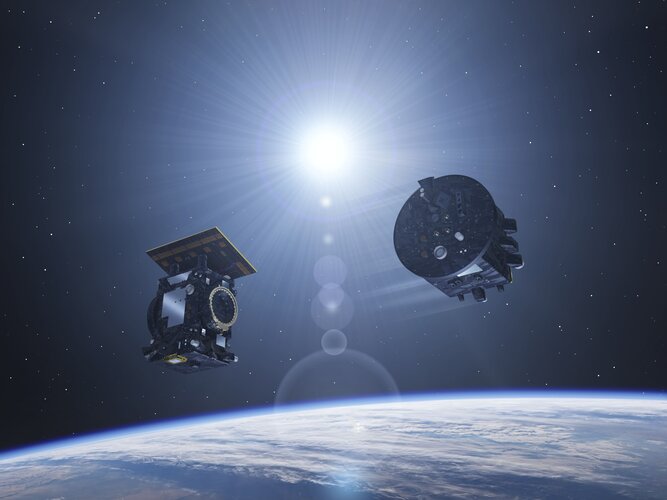ESA’s Highlights in 2025
Wednesday, 15 January 2025 07:13
This year will mark the European Space Agency’s 50th anniversary and promises to be a landmark year for the European aerospace industry. In addition to milestone events in our programmes, September will also mark 30 years of satellite navigation for Europe. This spring brings the second commercial mission involving a project astronaut to the International Space Station on Axiom Mission 4, while events such as ESA's Living Planet Symposium and the International Paris Air Show will gather the space community face to face.
IRIDE pathfinder satellite has launched
Wednesday, 15 January 2025 07:00
The first IRIDE satellite – the Pathfinder Hawk – is now in orbit around Earth after lifting off on a SpaceX Falcon 9 rocket from the Vandenberg Space Force Base in California on 14 January.
As its ‘Pathfinder’ name suggests, this new microsatellite is a prototype for one of the six IRIDE constellations, which are tailored to provide information for a wide range of environmental, emergency and security services for Italy.
Proba-3 becomes two: satellites separated
Wednesday, 15 January 2025 07:00
Last night a crucial step in the European Space Agency’s eclipse-making Proba-3 mission was completed: the two spacecraft, flying jointly since launch, have successfully separated. This leaves them ready to begin their cosmic dance in the world’s first-ever precision formation-flying mission.
H3 Varda's Second Spacecraft W-2 Successfully Launched to Orbit with SpaceX
Wednesday, 15 January 2025 03:50 Varda Space Industries has confirmed the successful launch of its second orbital processing spacecraft, W-2, aboard SpaceX's Transporter-12 rideshare mission. The spacecraft lifted off from Vandenberg Space Force Base in California and will orbit Earth for several weeks before re-entering the atmosphere and landing at South Australia's Koonibba Test Range.
This event marks Australia's firs
Varda Space Industries has confirmed the successful launch of its second orbital processing spacecraft, W-2, aboard SpaceX's Transporter-12 rideshare mission. The spacecraft lifted off from Vandenberg Space Force Base in California and will orbit Earth for several weeks before re-entering the atmosphere and landing at South Australia's Koonibba Test Range.
This event marks Australia's firs Investigating materials weathering at hypersonic velocities
Wednesday, 15 January 2025 03:50 When objects travel through the atmosphere at hypervelocity, they face potential damage from dust particles and water droplets suspended in the air. To better understand these interactions, researchers have developed innovative experiments that simulate weather conditions by observing how hypersonic bodies interact with droplets.
The experiments focused on the role of droplet size and shap
When objects travel through the atmosphere at hypervelocity, they face potential damage from dust particles and water droplets suspended in the air. To better understand these interactions, researchers have developed innovative experiments that simulate weather conditions by observing how hypersonic bodies interact with droplets.
The experiments focused on the role of droplet size and shap Health checks and suit installs before Thursday ISS spacewalk for science upkeep
Wednesday, 15 January 2025 03:50 Spacewalk preparations continued aboard the International Space Station as two astronauts conducted health checks and installed hardware on their spacesuits. Biology, physics, and lab maintenance also rounded out the Expedition 72 schedule on Tuesday.
Flight Engineer Nick Hague and space station Commander Suni Williams, both from NASA, began their shifts on Tuesday with standard health exa
Spacewalk preparations continued aboard the International Space Station as two astronauts conducted health checks and installed hardware on their spacesuits. Biology, physics, and lab maintenance also rounded out the Expedition 72 schedule on Tuesday.
Flight Engineer Nick Hague and space station Commander Suni Williams, both from NASA, began their shifts on Tuesday with standard health exa Astronomers catch unprecedented features at brink of active black hole
Wednesday, 15 January 2025 03:50 International teams of astronomers monitoring a supermassive black hole in the heart of a distant galaxy have detected features never seen before using data from NASA missions and other facilities. The features include the launch of a plasma jet moving at nearly one-third the speed of light and unusual, rapid X-ray fluctuations likely arising from near the very edge of the black hole.
The
International teams of astronomers monitoring a supermassive black hole in the heart of a distant galaxy have detected features never seen before using data from NASA missions and other facilities. The features include the launch of a plasma jet moving at nearly one-third the speed of light and unusual, rapid X-ray fluctuations likely arising from near the very edge of the black hole.
The This quasar may have illuminated the early universe
Wednesday, 15 January 2025 03:50 Quasars, among the universe's oldest and most luminous entities, are formed by active galactic nuclei (AGN) powered by supermassive black holes drawing in surrounding matter. These celestial objects emit electromagnetic radiation detectable across a broad spectrum, including radio, infrared, visible, ultraviolet, X-ray, and gamma-ray wavelengths. Their wide-ranging visibility makes them valuable
Quasars, among the universe's oldest and most luminous entities, are formed by active galactic nuclei (AGN) powered by supermassive black holes drawing in surrounding matter. These celestial objects emit electromagnetic radiation detectable across a broad spectrum, including radio, infrared, visible, ultraviolet, X-ray, and gamma-ray wavelengths. Their wide-ranging visibility makes them valuable XMM-Newton detects peculiar black hole X-ray patterns
Wednesday, 15 January 2025 03:50 The European Space Agency's XMM-Newton observatory has revealed unexpected X-ray oscillations emanating from the edge of a supermassive black hole in a nearby galaxy. These findings challenge existing theories of black hole accretion and offer intriguing clues about potential gravitational wave sources for ESA's upcoming LISA mission.
XMM-Newton's observations highlight the complexities of
The European Space Agency's XMM-Newton observatory has revealed unexpected X-ray oscillations emanating from the edge of a supermassive black hole in a nearby galaxy. These findings challenge existing theories of black hole accretion and offer intriguing clues about potential gravitational wave sources for ESA's upcoming LISA mission.
XMM-Newton's observations highlight the complexities of Hubble tracks down a 'blue lurker' among stars
Wednesday, 15 January 2025 03:50 The name "blue lurker" might sound like a villainous character from a superhero movie. But it is a rare class of star that NASA's Hubble Space Telescope explored by looking deeply into the open star cluster M67, roughly 2,800 light-years away.
Forensics with Hubble data show that the star has had a tumultuous life, mixing with two other stars gravitationally bound together in a remarkable
The name "blue lurker" might sound like a villainous character from a superhero movie. But it is a rare class of star that NASA's Hubble Space Telescope explored by looking deeply into the open star cluster M67, roughly 2,800 light-years away.
Forensics with Hubble data show that the star has had a tumultuous life, mixing with two other stars gravitationally bound together in a remarkable The beauty and danger of Solar Storms on Planet Earth
Wednesday, 15 January 2025 03:50 Solar storms, with their awe-inspiring displays like the aurora borealis, have captivated humans for centuries. However, these phenomena, caused by solar flares - intense bursts of energy from the Sun - pose significant challenges. Severe solar storms can disrupt telecommunications, satellites, and power grids, creating widespread consequences for global society.
Solar flares release high-
Solar storms, with their awe-inspiring displays like the aurora borealis, have captivated humans for centuries. However, these phenomena, caused by solar flares - intense bursts of energy from the Sun - pose significant challenges. Severe solar storms can disrupt telecommunications, satellites, and power grids, creating widespread consequences for global society.
Solar flares release high- Robotic SDSS telescopes revolutionize mapping the Milky Way
Wednesday, 15 January 2025 03:50 The Sloan Digital Sky Survey (SDSS) has launched its most advanced spectroscopic survey yet to create a detailed map of interstellar material within our Milky Way Galaxy.
"Our observing robots have been working hard for a few years already. Now, they are helping us scan the sky in a whole new way," said Dhanesh Krishnarao, an Assistant Professor of Physics at Colorado College and member of
The Sloan Digital Sky Survey (SDSS) has launched its most advanced spectroscopic survey yet to create a detailed map of interstellar material within our Milky Way Galaxy.
"Our observing robots have been working hard for a few years already. Now, they are helping us scan the sky in a whole new way," said Dhanesh Krishnarao, an Assistant Professor of Physics at Colorado College and member of What causes the white patch near northern lights
Wednesday, 15 January 2025 03:50 A whitish-grey patch that occasionally appears in the night sky alongside the aurora borealis has been explained for the first time, thanks to researchers at the University of Calgary. The phenomenon, known as "structured continuum emission," has long intrigued scientists but had never been fully understood until now.
The findings, published on Dec. 30 in the journal Nature Communications,
A whitish-grey patch that occasionally appears in the night sky alongside the aurora borealis has been explained for the first time, thanks to researchers at the University of Calgary. The phenomenon, known as "structured continuum emission," has long intrigued scientists but had never been fully understood until now.
The findings, published on Dec. 30 in the journal Nature Communications, NASA, Partners Invite Applications for CubeSat Summer Training Program
Wednesday, 15 January 2025 03:50 NASA, in collaboration with the U.S. Air Force and U.S. Space Force, is now accepting applications for a summer program designed to teach higher education institutions, faculty, and students the skills needed to build small satellites. This initiative also enhances the chances of participating teams being selected for future satellite flight opportunities.
The University Nanosatellite Prog
NASA, in collaboration with the U.S. Air Force and U.S. Space Force, is now accepting applications for a summer program designed to teach higher education institutions, faculty, and students the skills needed to build small satellites. This initiative also enhances the chances of participating teams being selected for future satellite flight opportunities.
The University Nanosatellite Prog Optimal Satcom surpasses 100 enterprise customers
Wednesday, 15 January 2025 03:50 Optimal Satcom, Inc., a global provider of satellite capacity management solutions, has surpassed 100 enterprise customers as of 2024. This milestone reflects the company's strong growth and leadership in delivering innovative satellite solutions. The company serves a diverse clientele, including the U.S. Government, allied governments, satellite operators, service providers, and industries such
Optimal Satcom, Inc., a global provider of satellite capacity management solutions, has surpassed 100 enterprise customers as of 2024. This milestone reflects the company's strong growth and leadership in delivering innovative satellite solutions. The company serves a diverse clientele, including the U.S. Government, allied governments, satellite operators, service providers, and industries such 
